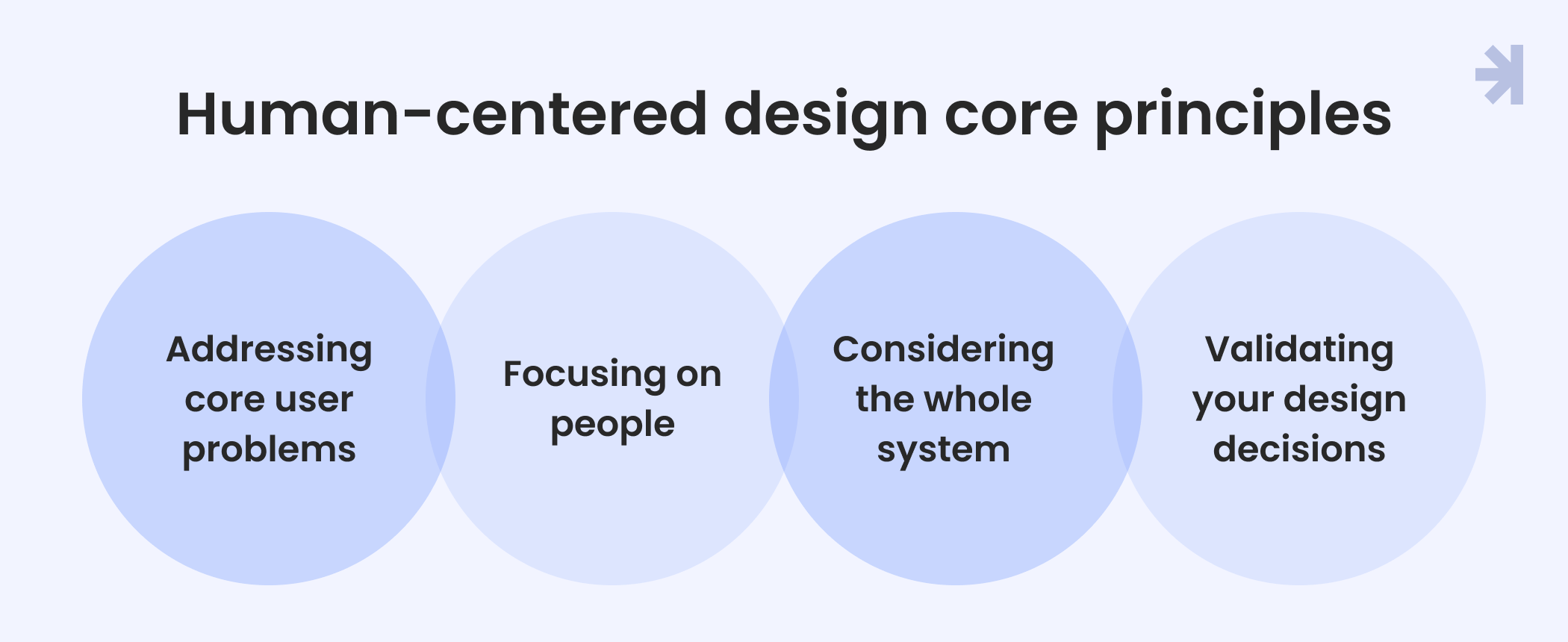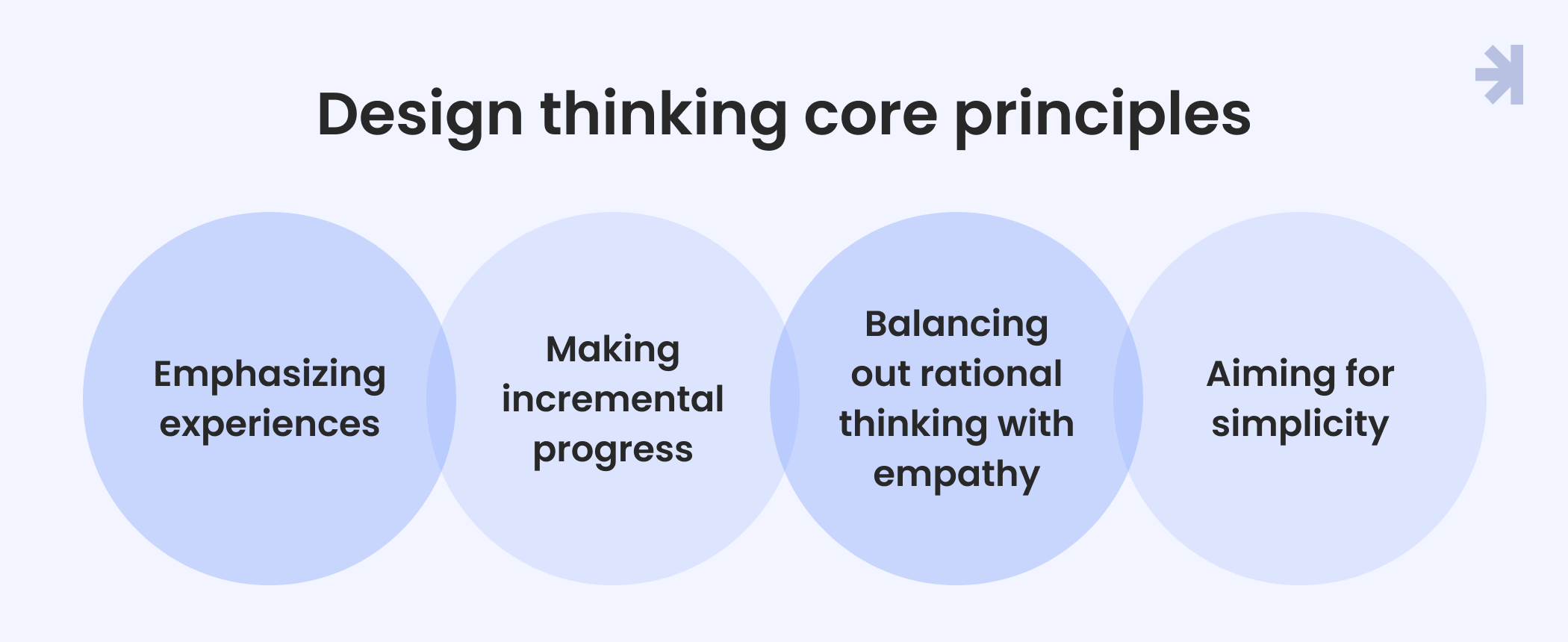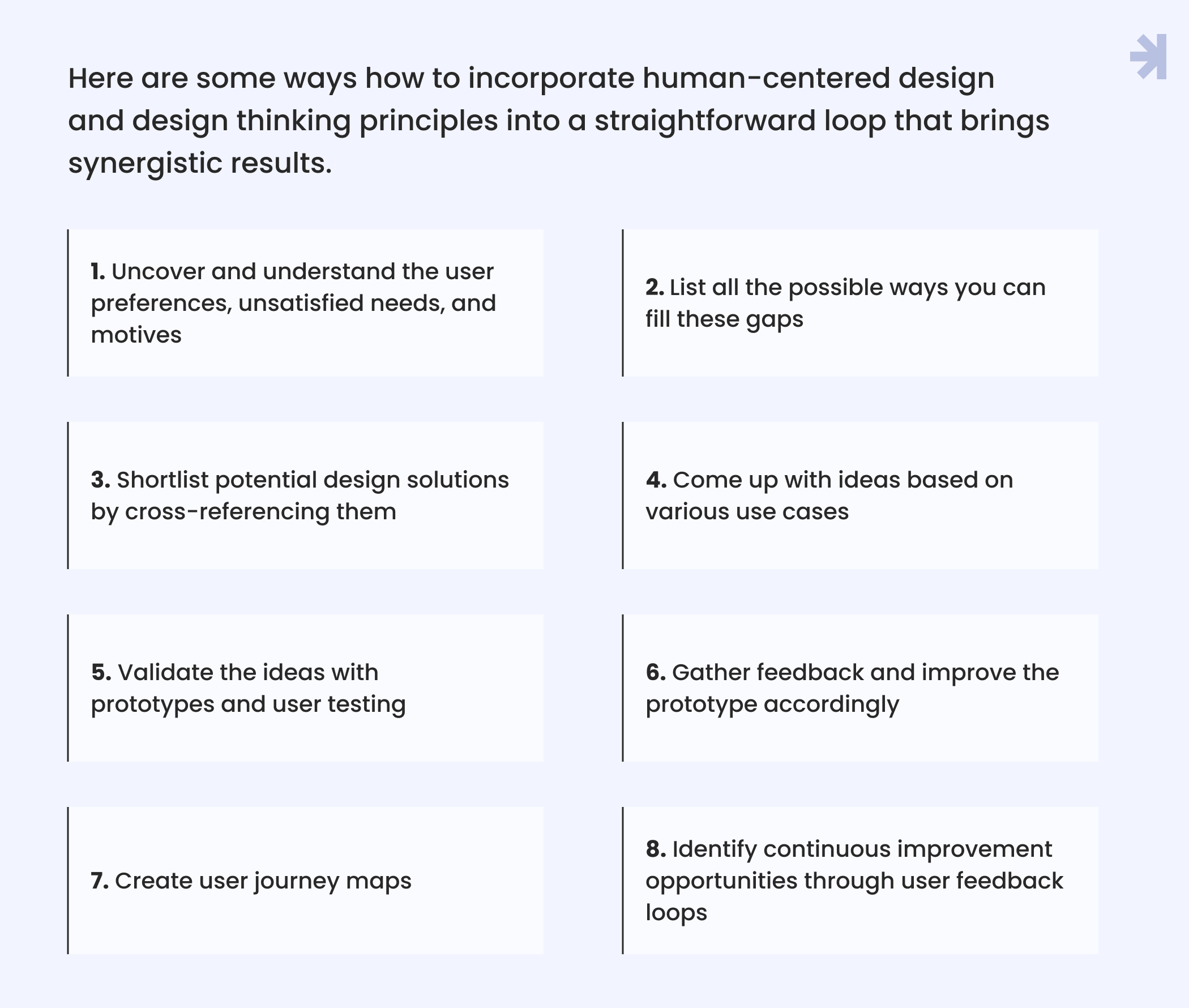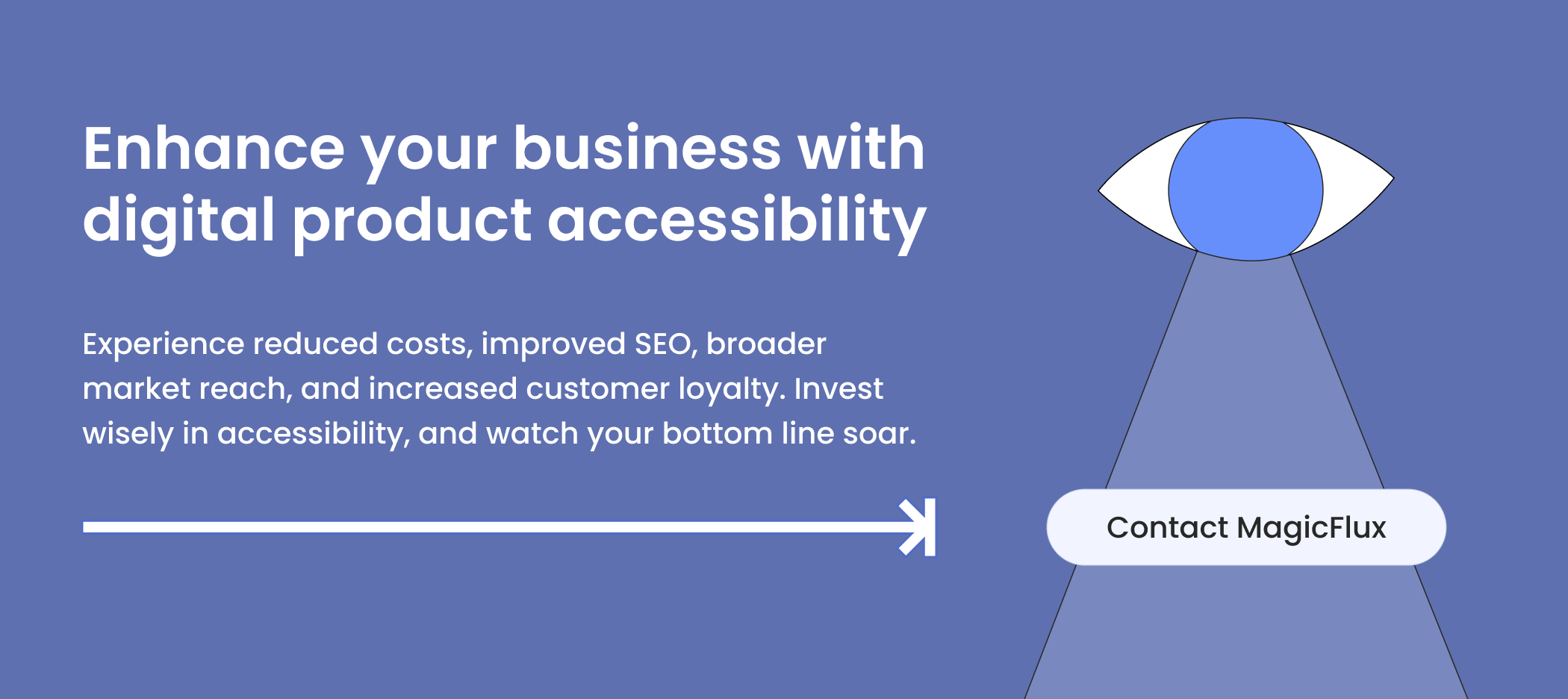Delivering a positive customer experience is still the secret sauce to a thriving business. A 2022 survey revealed that 94% of customers are more likely to purchase again if they have a positive experience with a brand. And 82% would even recommend the company.
This makes the user-centered design methodologies — human-centered design (HCD) and design thinking (DT) — powerful weapons to add to your product development arsenal. Even leading industry players are turning to them. Think Netflix, Airbnb, and Uber Eats.
Here, we’ll show you how to combine the two design approaches to foster synergy. But first, let’s define the concepts and get to grips with their underlying principles.
Understanding human-centered design (HCD)
HCD is an empathy-driven design methodology that puts the perspective of the end user at the forefront. HCD involves integrating user feedback, needs, preferences, and behavior into the product development process.

This design approach subscribes to the following core principles:
Addressing core user problems
Make sure you’re not just addressing symptoms. Cut right through to the underlying issues, as solving those lets you resolve a host of surface user problems.
Identifying fundamental issues requires time-consuming research. You must step into the real-world application of the design solutions. If you plan on creating products for, say, banks and financial institutions, then you must find a way to immerse yourself in the daily operations of these businesses and find out how your innovative solutions can make an impact. While you can’t just inject yourself into an institution, you can find a person who can show you the inner workings of the business.
Read more: Global Perspectives: Mastering Cross-Cultural Design Strategies
Focusing on people
Instead of building around your technological capabilities, create solutions that meet the needs, preferences, and abilities of people. You should bend the tech side to adjust to the human element, not the other way around.
Don’t just think of the users as an abstract concept. Observe them as they do their routine work or go about their daily lives. If you are offering a solution for doctors in a hospital, then you must observe them in that setting.
Consider the whole system
Don’t just home in on one part of the user journey. Improving just one aspect won’t guarantee a positive overall user experience. You must approach it as a system with many interconnected components. It is only by placing primary focus on the overarching system that you can ensure a great experience with your brand.
Case in point, making it easy for customers to sign up on an e-commerce app and search for the right products won’t matter much if they hit a hitch upon the point of purchase.
Validating your design decisions
Your initial prototype might look like a success, but you can only know for sure once the real users give it a go. Always keep in mind that you are not the user. Just because you’re happy with the prototype does not make it an instant hit. And don’t rely on your administrators, colleagues, or friends to do the user testing. It must be real users giving the prototype a try and telling you whether it meets their needs or not.
The results of these tests should guide your iterations and eventually result in an excellent product design.
What does HCD look like in a real-life setting? Let’s take a look at some examples.
Real-world examples that illustrate the application of human-centered design
Here are some ways companies have used HCD to build on an existing product and make it more attuned to the needs and preferences of the users.
Zero
Zero worked closely with their users to build an upgraded version of its fasting app. This resulted in a platform with an improved tracking interface, more comprehensive fasting guidelines, and the ability to sync with data in the cloud. The enhancements were made after analyzing user feedback and beta testing groups.
Zero’s human-centered approach allowed them to empathize and build a long-lasting relationship with their user base.
Muse
Ink and Switch built Muse, a design studio app for iPad and Mac, based off their foundation project Capstone. The latter is an experimental platform for Chrome OS tablets that enables creative thinking and brainstorming.
The design team built a prototype and made improvements based on the results of their extensive human-centric research and beta testing. After multiple iterations, they finally released the product to a wider customer base.
Next up, we’ll explore a similar yet distinct design approach.
Understanding design thinking (DT)
Design thinking is an iterative approach to addressing user needs with innovative solutions. Within this method, the design team moves quickly from ideation to prototyping to user testing on real users and keeps fine tuning the idea until it resolves the user problem. Only after that, full-scale development begins.

Design thinking adopts the following principles:
Emphasizing experiences
Design thinking goes beyond the traditional practice of focusing on the product and its features and functionality. This creative approach puts greater emphasis on paving the way for human experiences that address fundamental problems.
Making incremental progress
Product teams that adopt design thinking understand they must validate their idea and make several iterations before achieving perfection. They don’t get stuck in endless analysis but move forward with cycles of iterative prototyping and user testing.
Balancing out rational thinking with empathy
Rational considerations, such as cost-efficiency and technological capacity, are crucial to making sensible business decisions. Design thinking considers an often ignored but equally important factor — empathy for users. It puts as much weight on the qualitative understanding of emotions as on the quantitative evaluation of business figures.
Aiming for simplicity
Instead of confronting complex user problems with even more complexity, design thinking seeks simplicity. It breaks intricate issues into simplified user experiences, making it easier for product teams to address them.
Now that you have a better understanding of design thinking and its key principles, it’s time to explore its real-life application.
Read more: What’s the Difference Between Usability and Accessibility in Digital Design?
Real-world examples that illustrate the application of design thinking
Here are examples of real companies using design thinking to make quick iterations and pave the way for successful product development.
Airbnb
Putting ample emphasis on the human experience, Airbnb understood they needed to foster trust to encourage people to share their homes and time with travelers. A research-driven focus on real human behaviors and needs allowed their design team to marry together human preferences, technological feasibility, and economic viability.
Implementing DT principles, Airbnb would come up with a creative hypothesis, validate the idea, review its impact on the business, and then repeat the process. This iterative process has enabled them to become an industry leader credited with defining the experience economy.
To ensure a user-centered approach to their product development, the founders traveled to each location as a real user would. They ended up finding out that some solutions were as simple as using a high-quality camera to take great photos of the destination.
Citrix
Top executives from Citrix, a cloud computing company, attended a DT boot camp at Stanford d.school and came back committed to overhauling their internal design processes. They put together an internal team committed to instilling a culture of user-centered innovation in all company divisions.
The company has since grown to become a leader in design-driven excellence. Many other industry leaders have adopted user-centered approaches to design.
Uber Eats
Design thinking allows Uber Eats to confront complex logistical challenges with products that fuse together technology and people’s love for food.
Uber Eats sends designers out to immerse themselves in a city and learn about its food culture, transportation infrastructure, and restaurant industry. They also test their prototypes by observing firsthand how customers use them in the real world.
Rapid field testing and iterations have allowed Uber Eats to quickly create solutions and grow its customer base.
HCD and DT clearly bring enormous benefits, and they have certain overlapping attributes.

Similarities between HCD and DT
HCD and DT sound so similar, it’s easy to mistake one for the other. The following similarities are notable:
- HCD and DT are both driven by deep empathy, putting the end user front and center
- Both iterative, HCD and DT approaches repeatedly carry out user testing and make improvements
- HCD and DT use intensive market research and gather feedback to ensure the developers are in touch with customer sentiment
- Both approaches require close collaboration between the design team and end users
Despite these similarities, HCD and DT remain distinct concepts with separate use cases.
Differences between HCD and DT
What exactly makes HCD and DT distinctive from each other? Here are the key differences:
- DT is best used during ideation and product discovery while HCD is what you turn to once the actual development process starts or when you’re making enhancements to an existing product
- HCD puts the primary focus on user emotions while DT seeks to balance this out with rational considerations, such as the technical feasibility of the product
- DT paves the way for innovative solutions while HCD emphasizes usability
To reiterate, DT is best used during the early stages of product development while HCD is most beneficial for fine-tuning the product or adding new features.
Now you may be wondering how you can combine these design approaches. We’ll talk about that in the next section.
Synergies in action
You can incorporate HCD and DT principles into a straightforward loop that brings synergistic results. Here are some ways to implement this:

- Uncover and understand the user preferences, unsatisfied needs, and motives
- List all the possible ways you can fill these gaps
- Shortlist potential design solutions by cross-referencing them
- Come up with ideas based on various use cases
- Validate the ideas with prototypes and user testing
- Gather feedback and improve the prototype accordingly
- Create user journey maps
- Identify continuous improvement opportunities through user feedback loops
Keep repeating this design process until you’ve released the product and are adding new features to expand your user base.
Let’s consider a real-life application of this synergistic loop.
During its inception, Netflix demonstrated a flair for design thinking when it considered user needs and broke away from traditional means of providing DVDs to customers. At a time when the then industry giant Blockbuster was still requiring customers to take a trip to their brick-and-mortar stores to rent a DVD, Netflix put the users’ convenience first by offering a subscription model that delivered DVDs right to the customers’ doorsteps.
But Netflix saw its real business success when it continued to make improvements over the years, eventually offering on-demand streaming services that deemed their competitors obsolete. Even as it met with monumental business success, the company never sat on its laurels, adding even more new features to improve the user experience. It also responded to the customers’ search for original content by producing its own films and TV shows.
Conclusion
To accelerate your growth as a company, you need to adopt user-focused design methodologies. And this design approach must start right from ideation and continue up until you’re growing your user base with products and features that foster positive customer experiences.
And MagicFlux is just the design agency that can help make that happen. Contact us to find out how our expertise can improve your design processes.

FAQ
Is human-centered design (HCD) and design thinking (DT) the same?
These two design methodologies have overlapping attributes, such as the primary focus on empathy and iterations, but they are two distinct concepts with fundamentally different applications. DT is more applicable for product discovery and idea validation while HCD is the ideal methodology for adding new features or improving an existing product.
What is the effect of human-centered design thinking?
Because HCD closely considers user preferences and pain points, it’s much more likely to result in the creation of intuitive products that customers patronize.
What is the difference between design thinking and user-centered design?
DT brings rational considerations to the empathetic design process and emphasizes innovative solutions while HCD puts more weight on the users’ emotions and the product’s usability. The former is best used for the earlier phases of product development (i.e., idea validation) while the latter is particularly helpful for improving existing products (i.e., adding new features).
What is the design thinking process?
The design thinking process involves five phases, namely empathize, define, ideate, prototype, and test. It’s an iterative process that aims to gain a deep understanding of users, challenge assumptions, change the way you approach problem solving, build prototypes, and conduct user testing.

